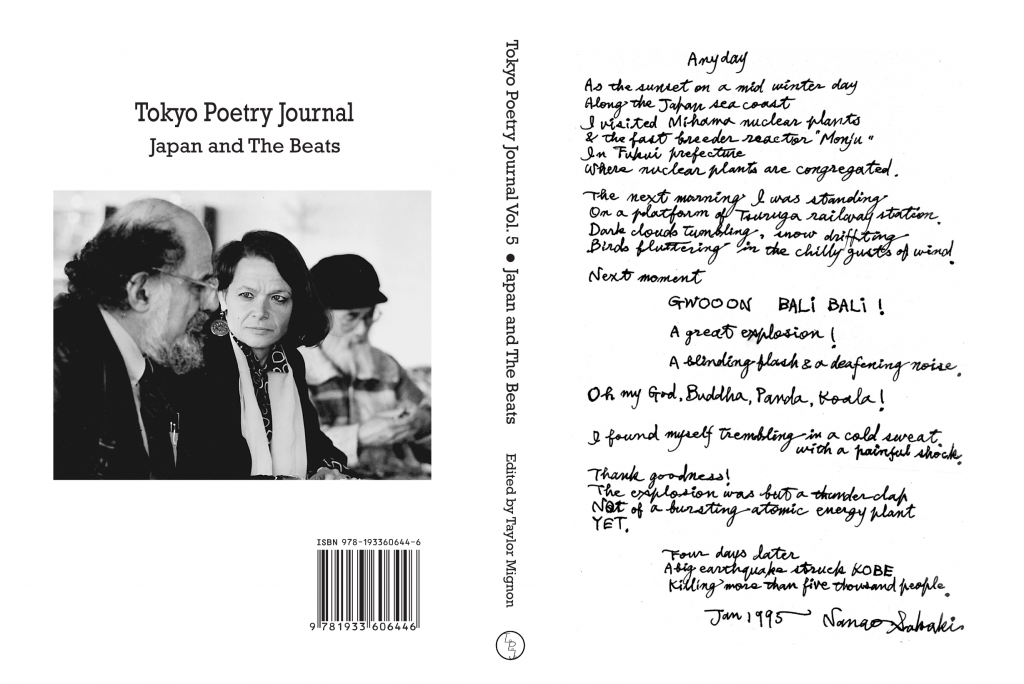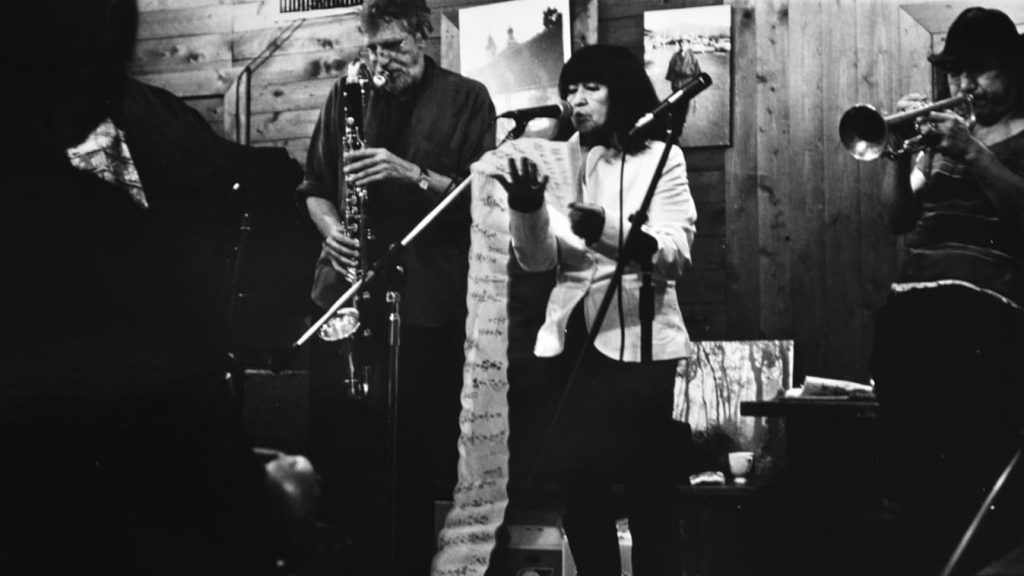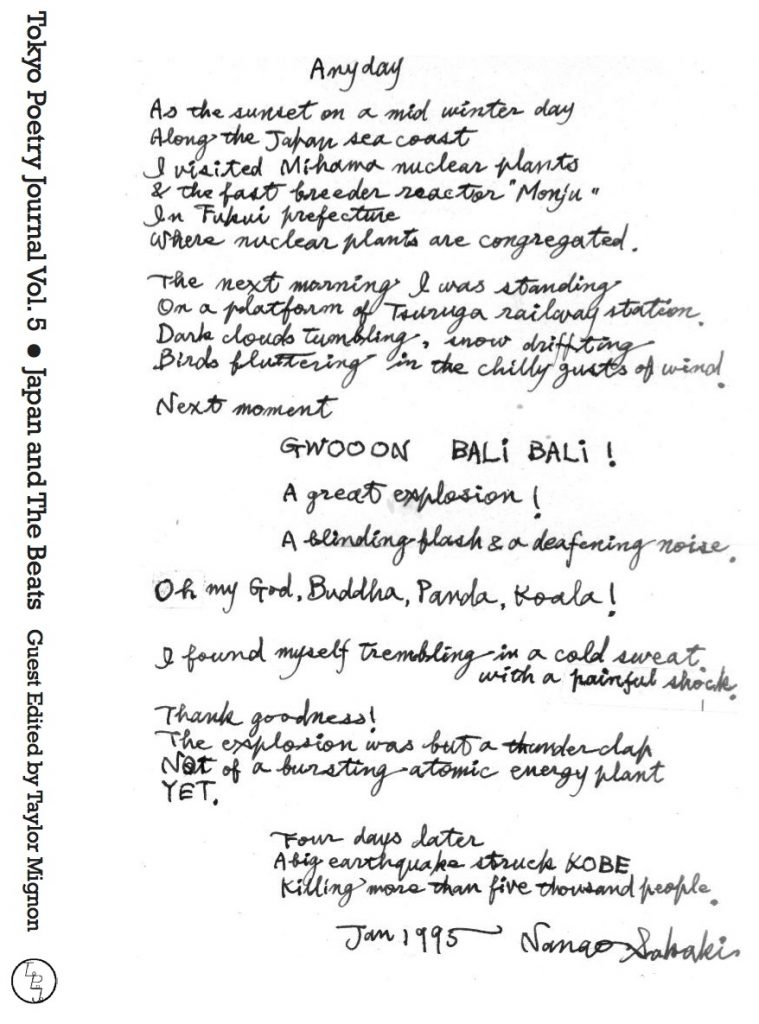A Review of TOKYO POETRY JOURNAL VOL. 5: ‘JAPAN AND THE BEATS’

There’s something deliciously cool about ToPoJo 5. There’s a handwritten poem on the front cover by Nanao Sakaki, with GWOOON BALI BALI! crying out for attention. There’s a back cover photo of Allen Ginsberg et al. in which his hair, jacket and tie stand out in stark contrast to the glossy whiteness of the cover. The journal’s title is on the back, Japanese style, as if to startle readers into fresh ways of seeing. ‘Always judge a book by its cover,’ said Oscar Wilde. He would undoubtedly have liked this one.
Inside the brilliance of the design continues to impress. To thumb through is a delight, with poems allowed sufficient space. Black and white photography breaks up the verbiage, prose offsets the poetry, there’s a drawing here, a scribble there, a caricature or two. Edith Shiffert gets six pages in her own write. You get the feeling that the editors care, not just about what poems mean, but about how they look. Here, even before reading, you can sense that poetry matters.
Inserted at the very front of the journal is a page of ‘Howl’, but not of course a conventional page. It begins with a Japanese version of the opening lines followed by a romaji transliteration, then a Google translation and a ‘gluey reverse translation’ before closing for reference sake with the original. It not only shows how things get lost in translation, but it forces attention onto the nuance of Ginsberg’s words.
The journal has 210 pages in all, far more than the typical book of poetry, and the Table of Contents runs to five and a half pages. The list of names is impressive; who would have thought the Beats and Japan would yield so much impressive material? There are memoirs, essays, interviews, and above all poems. Poems by those who lit the flame, and poems by those still guided by the light. Illustrious names stand out: a tribute to Kenneth Rexroth by Sam Hamill; Hillel Wright dreaming of Allen Ginsberg; leading Japanese poet Shiraishi Kazuko (hailed oddly as ‘the Allen Ginsberg of Japan’).

There is a significant input from Kyoto, showing that this most traditional of cities has a hip side too. Rexroth, even more than Snyder, looms large. From a useful introductory overview of Japan-related Beats by Taylor Mignon, we learn that Rexroth first visited Kyoto in 1967, returning in 1972 and then again from 1974-5 for a yearlong honeymoon. When he revisited in 1978, he gave a reading at Honyarado coffee shop with Shiraishi Kazuko and oral poet Katagiri Yuzuru as MC. He last visited Kyoto in 1980, and is said by Japanese to have been the poet with the best knowledge of Japan. In 2014 a celebration of Rexroth’s life took place at The Abode of No Guest and No Host, where he had once resided (the house is now located at Doshisha University campus on Imadegawa).
Apart from Rexroth, Kyoto is represented poetically by Cid Corman, Edith Shiffert and A.J. Dickinson as well as by an open letter to Jack Kerouac by Edward J. Taylor and an essay by Linda Russo on Jane Kyger (who lived in Kyoto with Gary Snyder for four years as his wife.) For all his prolixity (or perhaps because of it) Corman warrants a single short poem, about farting in front of Kinkaku-ji. Edith Shiffert on the other hand has six pages filled with her frail, irregular yet appealing penmanship in which the difficulties of life are offset by the solaces of nature and thoughts of transcendence.
Death, I will speak with you,
with my contortions as old as yours,
and my blindness and wanting
while I wait under the trees
Shiffert’s script is sometimes difficult to make out, in keeping with her subject matter of the difficulties of aging. The effect is to slow the reader down to a meditative pace and thus allow time for appreciation. It’s a shrewd choice by the editors. If you had to select one poet whose handwriting matched the content, Shiffert’s in old age would undoubtedly be a favourite.
Shiffert’s poems are followed by a short piece by A.J. Dickinson commemorating her death in 2017. ‘101 goodbyes / Kyoto beats / passings’. There’s a fresh Daoist hip feel to A.J.‘s poetry, which fits in neatly with the Beats. He himself has brushed cheeks with death this past year, and one of his four poems entitled ‘Quoth the invalid’ wonderfully encapsulates the extremes of the human condition, closing with the evocative last two lines – ‘the darkness / that shines’.
Such is the overall quality of this volume that only occasionally could the reader quibble about the selection. There’s a poorly written essay, an anti-Trump diatribe, a self-indulgent poem that overstays its welcome. But these are negligible given the wealth of material on offer here, material that otherwise would be hard to find. And credit must be given to the editors for keeping things moving along, for brevity is one of the volume’s great strengths and many of the one-page poems pack a satisfying punch. Questioned repeatedly about the Beats, Kizuki Mihiro was at first bewildered but eventually ‘I understood / It’s like Led Zeppelin for rock kids.’
But if there’s one person who encapsulates the whole volume, it’s the poet the editors have chosen to feature on their cover: the wonderful Nanao Sakaki (1923-2008). An indefatigable walker, he traversed forests and crossed borders, spending ten years in the US and befriending the original Beats. Through their interest in Buddhism (and Zen in particular), they had already formed a bond with Japan and Nanao was able to deepen it. Quirkiness, the search for authenticity, the desire for transcendence, the bond with nature, the striving to get beyond the self – he personified it all. ‘Break the mirror: How to live on Planet Earth,’ runs the title of his English-language volume.
Nanao’s first meeting with Allen Ginsberg took place with Gary Snyder in Kyoto in 1963, when the three of them visited five or six coffee shops, carried away on a wave of caffein. Just imagine! More than most Nanao understood the yearning of Beat poetry to morph into jazz. ‘Using my voice to sing a poem, hitting whatever is there to create free music, having something to dance to, adding a mantra to that, and using my voice until there is nothing left is the best thing,’ said Nanao about his style of performance. Renowned as a hippy free spirit, as a contemporary wandering poet, Nanao gets a tribute from David Cozy as being more than a spouter of words, but as a true craftsman and master of his art. He gets too a dedication poem from Anne Waldman: ‘You were / the hero in the forest.’
There’s no ‘Break the mirror’ here, but perhaps it’s too well-known for the editors. Instead there’s a gem with Top Ten of American Poetry, which runs through a listing of advertising slogans and other items of consumer materialism before ending with a killer punch.
The United States themselves are essentially the greatest poem.— Walt WhitmanThe government of the people, by the people, for the people.— Thomas JeffersonYou deserve a break today.— McDonald’sWhere science gets down to business.— Rockwell InternationalKick the letter habit.— Bell SystemCrime hits everybody. Everybody oughta hit back.— Chicago Crime CommissionWithout chemicals life itself would be impossible.— MonsantoI think America’s future is black, coal black.— Atlantic Richfield CompanyHave a coke and a smile.— Coca ColaPrivate property—No trespassing—Dead end road.— Anonymous
In a revealing interview with Shiraishi Kazuko in 1992 (translated here into English for the first time), Nanao remarks about a mutual friend being awarded the Order of Culture, ‘That is… a bit unfortunate. It’s best not to be awarded with something of that kind.’ Later he dismisses poetry as of little consequence. Like Hamlet, the true master of language can see it’s all just ‘Words, words, words.’ Nonetheless, for anyone who loves words, for anyone who can feel the beat, for anyone who has ever aspired to escape the banal, this is it, this is where it’s at. This is poetry as life and liberation, poetry as inspiration. If there’s ever a better Tokyo Poetry Journal than this, I truly want to see it!
(John Dougill)
For Tokyo Poetry Journal homepage, click here.
For Nanao Sakaki’s poem ‘Break the Mirror’, see here. For a wonderful selection of his other poems, click here.
For an article on Honyarado, see this CNN Style piece.

